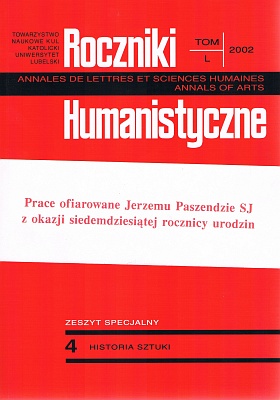The Miraculous Image of Our Lady of the Students From the Jesuit Church in Grodno
Abstract
The brotherhood under the invocation of the Annunciation to the Virgin Mary, to which pupils of the Jesuit school in Grodno belonged, received in 1664 the picture of Our Lady and Infant, famous for being miraculous. It is a copy of the famous painting from the Roman basilica Santa Maria Maggiore painted on tin; the cult of the painting, spread mainly by the Jesuits, belonged to the most popular ones in Poland. The half-figure presentation of Hodegetria, commonly called the Virgin Mary of the Snow, in Grodno received the name of Our Lady of the Students or of the Congregation. The introduction of the picture received a very solemn setting, and almost half a year later its miraculousness, confirmed by testimonies of numerous witnesses given under oath, was in a formal way approved of by the Vilnius bishop Jerzy Białłozór. In 1686 the Jesuits published a comprehensive brochure Summary of Our Lady of the Students’ miracles and excellent graces containing a description of the history of the painting and of 102 miracles that had happened until that time thanks to its intercession. Despite the affected exageration, typical of this kind of publications, the booklet contains a lot of useful information, not only about the history and forms of the cult, but also about events of a different kind, e.g. the information about construction of the first pharmacy in Grodno in 1686, not known from other sources, that is woven into the devotional narration. The descriptions from the Summary are complemented by equally naive paintings in the stalls, made for the chapel probably about 1730. Their artistic merit is not great, however, they become significant as an iconographic source, since they present two subsequent altars in which the miraculous picture was set: the original one of 1664 and the next one of about 1720. The pictures are primitive, but they are the only ones we have. In the paintings there is a documentation of its kind of the fact of stealing the silver ornaments of the picture and of decorating it with a golden dress founded by Kazimierz Jan Sapieha.
From the information contained in the church inventory of 1773 it follows that the dress was replaced by a new one, which was probably done simultaneously with the making of an impressive silver frame that, as the goldsmith’s marks found on it show, was made by Christian von Hausen in Gdań sk in 1761.
The above mentioned inventory also gives information about building a new stone altar in 1773; it highly values the advantages of its stucco sculpture decoration. It was made by the then Jesuit novice Tadeusz Podhajski. His name is not mentioned in the inventory but there are evident similarities to his later, confirmed, works.
Copyright (c) 2002 Roczniki Humanistyczne

This work is licensed under a Creative Commons Attribution-NonCommercial-NoDerivatives 4.0 International License.





